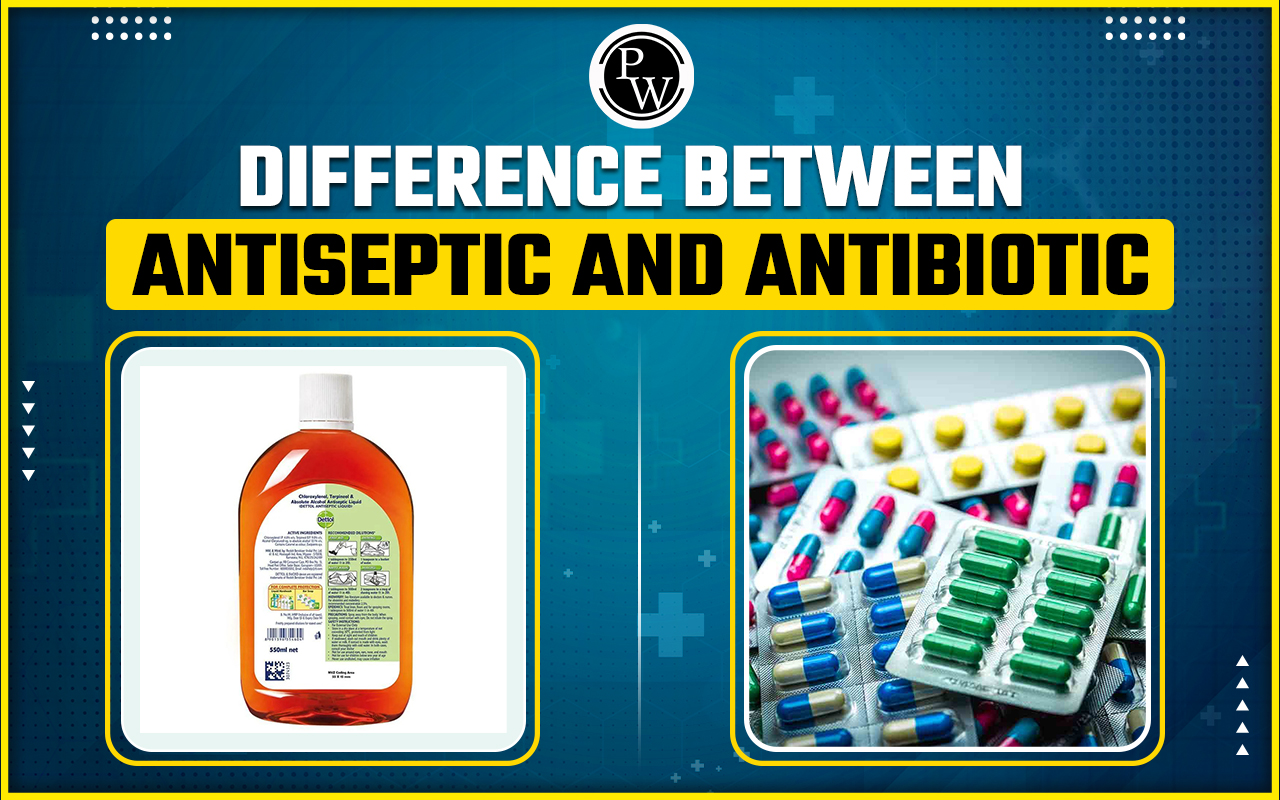

Difference Between Antiseptic And Antibiotic: Antiseptics and antibiotics play an important role in first aid treatment. Antibiotics are medications used to kill bacteria and prevent them from growing inside the body. Antiseptics, on the other hand, are chemical substances that are applied to living tissues to kill or inhibit the growth of a variety of microorganisms. While both antiseptics and antibiotics prevent microorganisms from growing, antibiotics are specific to bacteria, whereas antiseptics are effective against a wide range of microorganisms. Although these terms may appear to be interchangeable, they serve distinct functions and purposes. This article examines the difference between antiseptic and antibiotic.
| NEET Biology Syllabus | NEET Biology Diagrams |
| NEET Biology MCQ | NEET Biology Chapter wise Weightage |
| NEET Biology Notes | NEET Previous Year Question papers |
Difference Between Antiseptic And Antibiotic Overview
Many people believe that antiseptics and antibiotics are interchangeable because they both aim to prevent infections. They do, however, have some distinct differences. Antiseptics are typically prescribed as part of the initial treatment for cuts or wounds to reduce the risk of infection. They are applied externally and work to inhibit the growth of microorganisms, but they may not completely eliminate them. Antiseptics are commonly used in medical settings such as hospitals to reduce the risk of infection during surgical procedures.
Antibiotics, on the other hand, are highly effective medications used to treat bacterial infections. Antibiotics, as opposed to antiseptics, work against the bacteria already present in the body to help control infections by reducing their population. It is important to note that antibiotics are ineffective against viral infections like the common cold and flu. Alexander Fleming's discovery of penicillin in 1928 was a major breakthrough in antibiotic development, though he also warned about the possibility of antibiotic resistance. Antibiotics are effective against bacteria, but they can also cause diarrhoea, upset stomach, and nausea. The detailed difference between antiseptic and antibiotic are provided in the article below.
Difference Between Antiseptic And Antibiotic
Antiseptic and antibiotic are two important terms used frequently in the healthcare and infection prevention fields. Antiseptics are substances that prevent germs from growing on surfaces outside the body, whereas antibiotics are medications that treat bacterial infections. Students must understand the differences between antiseptic and antibiotics to grasp how they help keep us healthy and fight off infections. A difference between antibiotic and antiseptic is shown in the following table.
| Difference Between Antiseptic And Antibiotic | ||
| Feature | Antiseptic | Antibiotic |
| Purpose | Used externally to prevent the growth of microorganisms | Administered internally to treat bacterial infections |
| Application | Applied on surfaces outside the body | Taken orally or through injections to target bacterial infections within the body |
| Target organisms | Acts against a wide range of microorganisms on external surfaces | Specifically targets bacteria causing infections |
| Spectrum of activity | Broad-spectrum against various types of microorganisms | Narrow-spectrum, targeting specific types of bacteria |
| Mode of action | Inhibits the growth and reproduction of microorganisms | Interferes with bacterial cell wall synthesis or protein production to kill or inhibit bacteria |
| Development of resistance | Less likely to contribute to antibiotic resistance | Overuse can lead to antibiotic-resistant bacteria |
| Side effects | Generally low risk of systemic side effects | Can cause side effects such as allergic reactions, gastrointestinal disturbances, and antibiotic-associated diarrhea |
| Usage | Commonly used for wound cleaning, skin disinfection, and oral hygiene | Prescribed for bacterial infections like pneumonia, urinary tract infections, and skin infections |
| Frequency of use | Can be used frequently without concern for resistance development | To prevent antibiotic resistance, use sparingly. |
| Duration of treatment | Typically short-term for wound care and minor infections | May require longer courses of treatment to eliminate bacterial infections completely |
| Availability | Widely available over-the-counter and in healthcare settings | Need a prescription from a healthcare provider |
Antiseptic
Antiseptics are disinfectants that are specifically designed to prevent wound infections and the development of sepsis. Antiseptics, unlike antibiotics, are applied externally to the affected area rather than taken orally. Their primary goal is to reduce the presence of bacteria and germs in wounds by killing or neutralizing them, resulting in bactericidal, bacteriostatic, and fungicidal activity. Alcohols, high-quality cetrimide, and triclosan are common types of antiseptics.
Antiseptics, unlike antibiotics, can affect human cells. They adhere to cell walls or membranes, disrupting metabolic processes, toxins, and enzymes, resulting in cell death. While not highly specific, this mechanism makes it unlikely that targeted cellular responses will occur, making resistance development nearly impossible. The characteristics of antiseptics:
- Antiseptics are externally applied to the skin or mucous membranes to thwart the growth of microorganisms and diminish the risk of infection.
- Antiseptics exhibit a wide range of activity, capable of inhibiting the growth of various bacteria, viruses, and fungi.
- Antiseptics are generally deemed safe for external use and do not pose harm to human tissues or organs.
- Antiseptics function by either destroying or inhibiting the growth of microorganisms, thereby facilitating wound healing and preventing infections.
- Antiseptics are available in diverse formulations such as solutions, creams, gels, and sprays to ensure convenient and effective application.
Antibiotic
Antibiotics are naturally occurring metabolites produced by fungi or bacteria that can inhibit or kill the growth of other microorganisms, even at low levels. While antibiotics and antiseptics have similar requirements, antibiotics were originally developed in the early 1910s to treat bacterial diseases systemically.
Antibiotics, despite their natural origin, have been synthetically produced since their discovery and are now entirely synthetic. Antibiotics are typically administered systemically, but they can also be administered locally in some cases. However, this approach is generally avoided due to the increased risk of allergic reactions and the possibility of resistance development.
Antibiotics are effective against specific bacteria, but their widespread use can lead to systemic side effects. Nonetheless, they exhibit selective toxicity, targeting bacterial cells while sparing human cells by utilizing structures unique to bacterial cells.
Antibiotics must be used with caution because improper or frequent use can lead to bacterial resistance, rendering the antibiotics ineffective. As a result, they should only be used as needed. The characteristics of Antibiotics include:
- Antibiotics specifically target bacteria and function by either inhibiting their growth or killing them.
- Antibiotics exhibit selective toxicity, meaning they can target bacterial cells without causing significant harm to human cells.
- Antibiotics may have a narrow or broad spectrum, depending on their effectiveness against specific or a wide range of bacterial species.
- Antibiotics are prescribed at precise dosages and durations to ensure effective eradication of the infection and to prevent the development of antibiotic resistance.
- Antibiotics are available only with a prescription from a healthcare professional to prevent misuse or overuse.
Physics Wallah provides the online coaching for NEET exam in India, with high-quality training at a reasonable price. NEET Online Courses by PW which have been skillfully designed to help students excel in their NEET exam preparation and succeed in the highly competitive NEET exam. Physics Wallah connects students with highly qualified teachers who specialize in explaining complicated ideas.
Difference Between Antiseptic And Antibiotic FAQs
What distinguishes between antibiotics and antibacterials?
What are typical antiseptics?
Which antibiotic treats all infections?
Is Dettol considered an antiseptic?
What are three commonly utilized antiseptics?












